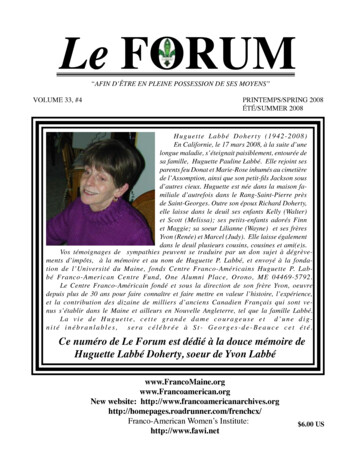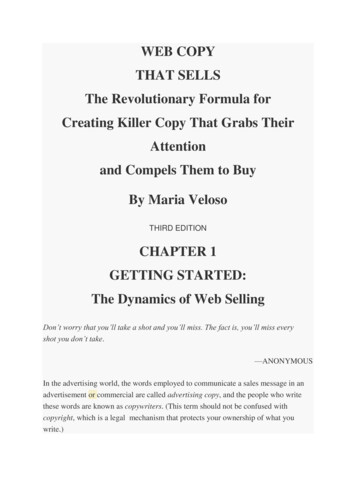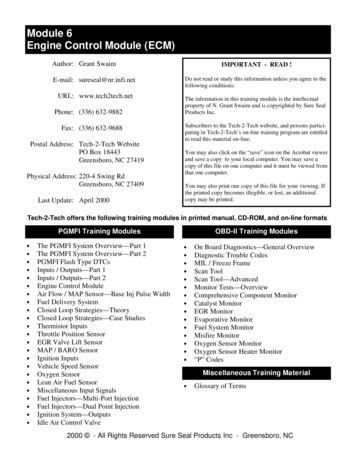
Transcription
Le FORUM“AFIN D’ÊTRE EN PLEINE POSSESSION DE SES MOYENS”VOLUME 33, #4PRINTEMPS/SPRING 2008ÉTÉ/SUMMER 2008Huguette Labbé Doherty (1942-200 8 )En Californie, le 17 mars 2008, à la suite d’unelongue maladie, s’éteignait paisiblement, entourée desa famille, Huguette Pauline Labbé. Elle rejoint sesparents feu Donat et Marie-Rose inhumés au cimetièrede l’Assomption, ainsi que son petit-fils Jackson sousd’autres cieux. Huguette est née dans la maison familiale d’autrefois dans le Rang-Saint-Pierre prèsde Saint-Georges. Outre son époux Richard Doherty,elle laisse dans le deuil ses enfants Kelly (Walter)et Scott (Melissa); ses petits-enfants adorés Finnet Maggie; sa soeur Lilianne (Wayne) et ses frèresYvon (Renée) et Marcel (Judy). Elle laisse égalementdans le deuil plusieurs cousins, cousines et ami(e)s.Vos témoignages de sympathies peuvent se traduire par un don sujet à dégrèvements d’impôts, à la mémoire et au nom de Huguette P. Labbé, et envoyé à la fondation de l’Université du Maine, fonds Centre Franco-Américains Huguette P. Labbé Franco-American Centre Fund, One Alumni Place, Orono, ME 04469-5792.Le Centre Franco-Américain fondé et sous la direction de son frère Yvon, oeuvredepuis plus de 30 ans pour faire connaître et faire mettre en valeur l’histoire, l’expérience,et la contribution des dizaine de milliers d’anciens Canadien Français qui sont venus s’établir dans le Maine et ailleurs en Nouvelle Angleterre, tel que la famille Labbé.La vie de Huguette, cette grande dame courageuse et d’une dign i t é i n é b r a n l a b l e s , s e r a c é l é b r é e à S t - G e o rg e s - d e - B e a u c e c e t é t é .Ce numéro de Le Forum est dédié à la douce mémoire deHuguette Labbé Doherty, soeur de Yvon Labbéwww.FrancoMaine.orgwww.Francoamerican.orgNew website: ges.roadrunner.com/frenchcx/Franco-American Women’s Institute:http://www.fawi.net 6.00 US
Le ForumLe Centre Franco-AméricainUniversité du MaineOrono, Maine 04469-5719Lisa Michaud@umit.maine.eduTéléphone: 207-581-FROG (3764)Télécopieur: 207-581-1455Volume 33, Numéro 4Printemps/ÉtéÉditeur/PublisherYvon A. LabbéRédactrice/Gérante/Managing EditorLisa Desjardins MichaudMise en page/LayoutLisa Desjardins MichaudComposition/TypesettingLisa MichaudAngel SiroisNaomi MuhlbergAric CloutierAide TechniqueLisa MichaudYvon LabbéTirage/Circulation/4,500Imprimé chez/Printed byCentreFranco-Américain, Orono, MainePublié 4 fois l’an par le Centre Franco-Américain. Le Forum est distribué surtout auxFranco-Américains des États-Unis. Lesénoncés, opinions et points de vue formulésdans Le Forum sont ceux des auteurs et nereprésentent pas nécessairement les pointsde vue de l’éditeur ou de la rédactrice, ou dela Division pour l’Éducation Permanente àl’Université du Maine.Le Forum is published 4 times a yearby the Franco-American Center. Le Forum isdistributed in particular to Franco-Americansin the United States. Statements, opinions andpoints of view expressed are not necessarilythose of the editor, the publishers or the Divisionof Lifelong Learning or of the University ofMaine.Tous les textes soumis doivent parvenirà —Forward all submitted texts to: Lisa D.Michaud, Rédactrice-en-chef/Editor-in-chief,Le Forum, University of Maine, Orono, Maine04469-5719, U.S., au plus tard quatre semainesprécédant le mois de publication—at least fourweeks prior to the month of publication.Les lettres de nos lecteurs sont les bienvenues—Letters to the Editor are welcomed.La reproduction des articles est autoriséesans préavis sauf indication contraire—Ouroriginal articles may be reproduced withoutnotice unless otherwise indicated.L’équipe de rédaction souhaite que Le Forum soit un mode d’expression pour vous tousles Franco-Américains et ceux qui s’intéressentà nous. The staff hopes that Le Forum can be avehicle of expression for you Franco-Americansand those who are interested in us.L e F o r u m e t s o n s t a f f — U n iversitaires, gens de la communauté,les étudiants --Angel, Naomi et ’États du Maine.4-17Quebec, a City of Superlatives by Denise LarsonEdouard "King" Lacroix by Charles FrancisMa Grand-Mère Sirois by Annette Paradis KingA Red Superstition / Une Superstition Rouge by / par Virginie SandOur March to Quebec by Denise LarsonThe Canadian Census of 1666 by Denise LarsonHandicrafts in Canada by Denise LarsonAn Influential Woman - My Grandmother, Evelina Lachance by Evelyn Lachance"Franco-American Day at the State House" submitted by Pearley LachanceSeverin Béliveau Receives French Legion of Honor by Juliana L'HeureuxLe KKK Au Maine Selon Dr. Mark Richard by Nicole OuelletteL’États du New Hampshire.20, 21, 28, 29, 30François Bélanger et Marie Guyon à Beauport (1634-1641)soumis par Jim BélangerL’États du Connecticut.22, 38-43, 46, 47Sitcha Deported to the Cameroon by Albert MarceauMarcel Roy, Member, Director and Past President of FCGSC, Is Rememberedby Albert Marceau25 Years of the FCGSC: Part Three by Albert MarceauGuest Writers.18, 19Golden Threads by Lina MarksQuébec City 1608-2008 400th Year Anniversary by Anne Marie LeonardBooks/Livres.23, 24, 36, 37Genealogy/Généalogie.17, 50-54Query from Lucy ProulxPoetry/Poésie.25-26Coin des jeunes.27Music/Musique.44-45, 48Les Français d’Amérique / French In AmericaCalendar Photos and Texts from 1985 to 2002Project of: Virgil Benoit, Red LakeFalls, MinnesotaPlanning & Execution by: Marie-ReineMikesell, Chicago, IllinoisAlliance Franco-Américaine du Midwest(AFAM)Dessin deCharles E. Beaudet, MichiganConseil pour le Développement duFrançais en Louisiane (CODOFIL)Société Historique Franco-Américainede la Nouvelle-Angleterre (SHFA)http://www.johnfishersr.net/french in america calendar.html
Vol. 33 # 4 rg/New!The history of Franco-Americans has been omitted for generationsfrom the history books due to the politics and discrimination Francos facedin employment and social settings.The history of Franco-Americans,like Native Americans, has long since beenleft out of school curriculum so our younger generations are becoming less aware oftheir roots, their language and their history.Franco-Americans have a proudethnic heritage that needs to be preserved.L’histoire des Franco-Américainsa été omise des livres d’histoire depuisplusieurs générations à cause de lapolitique et la discrimination auquellesles Francos ont fait face dans leursituation d’emploi et leur milieu social.L’histoire des Franco-Américains,tel que celle des Amérindiens, depuis longtemps sont absentes du curriculum de nosécoles. Il en résulte que nos jeunes deviennent de moins en moins conscient deleurs racines, leur langue et leur histoire.Les Franco-Américains possèdentun fier héritage qui doit être préservé.Absente les voix de leur vécu, l’histoireThe history of the Franco-Americansis not complete without the inclusionof the voices that lived the experience.To that end, the Franco-American OralHistory Archives is to create and preserve a more complete record of thehistory of Franco-American experiencein the northeast by preserving recordedinterviews, the recollections and experiences of all who are Franco-American.The mission of the Franco-American Oral History Archives is two-fold.des Franco-Américains est incomplète.À cette fin, les Archives d’histoire oralefranco-américaine se veut un moyende préserver et d’enregistrer l’histoirede l’expérience franco-américaine dunord-est en conservant les entrevuesenregistrées, le souvenir et l’expériencede tous les Franco-Américains.La mission des Archives oralesfranco-américaines a deux volets. Dansun premier temps, c’est de développer,de collectionner, d’archiver, et de rendredisponible au grand public une documentation orale se rapportant à l’histoirepersonnelle, ethnique, politique, etNouveau!The mission of the Franco-AmericanOral History Archives is to develop,collect, archive, and make available tothe public oral documentation pertaining to the personal, regional, ethnic andpolitical histories of Franco-Americans.As a public history, it is to connect theacademy with the community by promoting family/community studies, historicpreservation, heritage tourism and hightechnology media in order to enrich historical understanding in public memory.régionale des Franco-Américains. Dansun deuxième temps, et comme histoirepublique, c’est de relier l’académie avecla communauté en promouvant les étudescommunautaires et de familles, la préservation historique, l’héritage touristique,la technologie de pointe des médias, ceciafin d’enrichir la compréhension historique de la mémoire collective publique.This site is underconstruction, please bearwith us!Veuillez patienter, ce siteest en pleine construction!3
Le Forumcines to the residents of the post and servedin many civil capacities. His wife, MarieRollet, welcomed orphan Native American children and ran a school for them.Champlain built his l’Habitationin Lower Town in order to have easy acBy Denise R. Larson cess from the river to the trading post forthe hunters who brought in furs and forQuebec is a small city and the the ships from France that brought suponly fortified one in North America. The plies and trading goods to Quebec. Thewall that encloses Quebec is thirty-five church Notre-Dames-Des-Victoires infeet high and about two miles long. In- the Place Royale stands on the site of theside its confines are Upper Town, which trading post. The courtyard of the squareincludes the Citadel on Cap Diamant and is the former location of Champlain’sthe area north of it; and Lower Town, garden. The church, built in 1688, iswhich lies between the cliffs of Cap considered the oldest one in Canada.Diamant and the Saint Lawrence River.For more superlatives, the streetIn Upper Town, the Chateau Fron- called Sous-le-Cap is only eight feet, tentenac occupies the site of Fort St. Louis, inches wide, and is considered the narwhich was built by Samuel de Champlain rowest street in North America, which isand his men to protect a trading post that not surprising as it is one of the oldest,was founded in 1608. The apothecary too. However, the oldest street in QuebecLouis Hebertbuilt a stone house near the and the oldest commercial street in Northfort. From his home he dispersed medi- America is thought to be Rue du Petit-Quebec, a City ofSuperlativesChamplain, which served as the mainthoroughfare during seventeenth-century.Quebec City is old, and it sitsalong the Appalachians, the world’soldest mountains, which have beenso worn down by weather and timethat they are not much more than rolling hills in most places. Forests cloakthem. Hiking trails weave throughthem. People love them. People love,too, the history and quaintness of oldQuebec. We hope that la belle ville willhave a very happy 400th anniversary.Denise R. Larson can be reached atfrancadian@yahoo.com. She is theauthor of Companions of Champlain:Founding Families of Quebec, 16081635, published by Clearfield Companyof Baltimore; 1-800-296-6687; www.genealogical.com; Item #9914. 22.95 plus 4 postage and handling.Edouard "King" LacroixAnd his impossible Umbazooksus andEagle Lake Railroadby Charles Francis(NDLR: This article first appeared in the Discover Maine, Vol.5, Issue 1. The photos accompanying this article are usedwith permission from the Patten Lumberman's Museum).Eagle Lake is one of the most beautiful lakes in Maine, even if its waters area light shade of tea-brown. The tea-browncolor is the result of some 100 years oflogging. Over that period giant logs wereleft behind by various logging companiesto sink to the bottom. It is tannic acid fromthe decomposition of the logs which is themost likely source of the discoloration.The Eagle Lake region is famousfor a number of reasons. In 1846 HenryDavid Thoreau got this far on his trip tothe Allagash. Then, long after Thoreaucame here with his Indian guides, someadventurers claim to have seen strangelights in the sky, describing them inways so that even today, die hard UFOologists continue to make pilgrimageshere in hopes of seeing flying saucers.The region is also famous for the Umbazooksus and Eagle Lake Railroad, therailroad that some said was impossibleto build so far into the north woods.4Unloading cars at the Umbazooksus,Eagle Lake & West Branch Railroad.(Photo courtesy of the Patten Lumbermen’s Museum)Back in the mid-nineteenth cen- before the Civil War. The canals were atury, Churchill Dam was the hub of less-than-successful solution, however. Itlumbering operations in the Allagash took a fair amount of time to float logs onregion. Today one can still find pieces the slow-moving canal waters and theyof steam-driven apparatus and remains were continually getting hung up. Then,of the buildings that once housed the around 1900, mechanization stepped in.woodsmen and their timber cutting equipThe first indication that the northment still standing. The dam that exists woods was about to enter the twentiethtoday is a new one built to control water century came with the construction of aheight on the lower Allagash for pur- tramway between Eagle and Churchillposes of recreational boating and fishing. lakes. The 3000-foot-long tramway conIn the days before gravel roads sisted of a system of steam-driven axleshoneycombed the north woods, logs were which transported logs from Eagle Lakefloated downriver to the mills of central to Churchill. From Churchill the logsMaine from the Churchill Lake region. were floated down to the mills of MilliThere was a problem with this, however. nocket. The tramway operated for aboutNot all the rivers of the region run to cen- six years starting in 1903. It ceased operatral Maine. Some flow to Canada. The first tion when the timber around Eagle Lakeapproach to dealing with the problem was was logged out. That appeared to be thea system of canals that were built shortly (Continued on page 5)
(Edouard "King" Lacroix continuedfrom page 4)end of rail operations for the north woods.At least, it was the end, until an inventive Canadian by the name of Edouard“King” Lacroix appeared on the scene.Edouard Lacroix was a big-timetimber cutter with bases of operation inQuebec and New Brunswick, includingMadawaska on the Canadian side of theborder. Starting about 1920, King Lacroixbegan buying up timber rights in the Allagash region. The timber he cut wentto central Maine, primarily Millinocket.Lacroix, however, was experiencing thesame problems moving his timber to central Maine that had plagued his predecessors. His solution was the Umbazooksusand Eagle Lake Railroad, the railroadthat many said could never be built.Lacroix began building his railroadat Eagle Lake in 1926 not far from theold tramway. (By this time there was anew stand of timber in the Eagle Lakeregion). The line extended in a westerly direction and went for a distance ofthirteen miles down the shore of Chamberlain to the head of Umbazooksus.Building materials for the Umbazooksus and Eagle Lake were brought induring the winter of 1926-27 using Lombard Log Haulers. The Lombards evenbrought in the two steam locomotives thatwere used on the line. The biggest part ofthe job was the construction of the 1500foot trestle across the Allagash, whichhad to be strong enough to support themassive weight of the pulp cars. The trestle was designed by Max C. Hilton, oneof the most knowledgeable figures in thehistory of logging in northwestern Maine.The Umbazooksus and Eagle Lakehad a very short history. Almost immediately after its construction, it waspurchased by the Great Northern PaperCompany. Under this new ownership, aEnd of cars loaded , on track,Eagle Lake & West Branch Tramway.(Photo courtesy of the Patten Lumbermen’s Museum)Engine & cars along track,Eagle Lake & West Branch Railroad.(Photo courtesy of the Patten Lumbermen’s Museum)Vol. 33 # 4 PRINTEMPS/ÉTÉsystem of conveyors to assist in the loading operation was added at Eagle Lake,and the name was changed to the EagleLake & West Branch Railroad. King Lacroix, however, was kept on to manage it.During the seasons when therails were free from ice and snow, therailroad operated twelve hours daily.There were usually ten to twelve cars toa train, each car carrying approximatelytwelve cords of wood. To facilitate speedthere was a double track at the middleof the run so that trains could pass. Thismeant that an empty train could be returning to Eagle Lake while a full onewas making its run to Umbazooksus.King Lacroix’s “impossible railroad” operated until 1930. The end ofthe operation came when the EagleLake region was again logged off. Atthat point the locomotives were runinto sheds, shut down and abandoned.Edouard LaCroix's Gasoline Lombard Log Hauler #6.(Photo courtesy of the Patten Lumbermen’s Museum)Eagle Lake Camps.5
Le ForumMa Grand-Mère SiroisAnd the Value of a Family GenogramBy Annette Paradis KingIf I were to give recognition to oneperson for my interest in writing our family history, it would be mon Grand-MereSirois. That’s right, yet a tad odd, for therewas no verbal exchange or encouragement that went on between us that mighthave directed me to write our history.Mon Grand Meme actually didn’t leavebehind anything that might have broughtthe two of us closer to sharing an interestin family history. Something as smallas bits of handwriting found tucked hereor there, a letter, or even a birthday cardwith a personal message were nothingbut fantasies on my part. Those deficiencies, however, were enough to send meadamantly gathering and documentingevents large and small taking place in myown daily life. My grandchildren, whentheir curiosities begin to stir, will havea family genogram waiting for them.relied on other authors’ of the early 20thcentury to guide me. My maternal andpaternal great-grandparents migratedfrom Quebec to Maine in the mid-eighteen-hundreds. Why these folks came toMaine and how, has been deduced frommany years of reading other authors opinions. This has been a rewarding experience that re-kindled an enormous amountof pride. We come from hard workingpeople and possibly that’s enoughto comprehend and to give homage.Ma Grand-MèreMa Grand-Mère Sirois remainsan endearing woman in my heart. Evennow I remember her strength of characterand unshaken faith. She was a rigidlyformal little woman, worn out for her age,reserved enough to hold back hugs andkisses, carrying a soap and water scent,wearing a crown of gray hair, showingtraces of aging with a hunched back,footing unsteady, dark close-set eyesthat twinkled regardless, when focusedon me. I think also of the many sufferings she endured simply to exist. Sadly,I feared that what I could rememberwas about all we’ll ever know of herand other women of her generation, myancestors. She died at the age of fiftyeight and before my seventh birthday.The tragedy of her early death wascompounded by the fact that she neverhad the opportunity to learn to read andwrite, and even if she had, the time to doso may not have been hers to squander.In any case, mon Grand Memewasn’t a story teller so in order to understand what life was like for her, I have6Grand-Mère SiroisEllen Beaulieu SiroisOther WritersMy life is a comfortable one incomparison to my grandmother, considering she died young. It is a goodpossibility the lack of any medical treatment shortened her life. The obstaclesthese poor souls faced for decades arewell documented, and I have read storiescovering similar situations. The Bellesof New England by William Moran,tells how our ancestors came to NewEngland, and includes several stories ofdying women young. The fear of speaking up was wide-spread as well as howour people were easily led (or miss-led)by factory owners, their overseers andeven the parish priests. It took generations before independence appearedacross the board as we know it today.The idea of independence is alsoprominent in Carolyn G. Heilbrun’sinteresting book, Writing a Woman’sLife. What I found most importantfrom its 128 pages was that a womanmust work toward independence earlyin her life. The facts were loud andclear. If she can support herself, shewill have money of her own; if she hasmoney she will have power. By powerI mean the ability to do anything shewants, i.e., write, paint, travel, createand eventually even marry a true partner.It is the dependency on anotherthat discourages dreams from developing, Heilbrun wants the reader to realize.If dreams are lost, she says laughter is,too. A woman not only needs a room ofher own, (as Virginia Woolf famouslyproposed) but a bank account of herown as well, which comes by working hard at what one likes best. Thewomen of my generation were taughtto search for and ‘catch’ someone whowould take better care of us then ourfathers. Heilbrun suggests that a goodmarriage is formed on intellectual parity.This book offers the knowledgeI never gave much thought to before. Idon’t think May Sarton addressed independence the same way nor did WillaCather or Leo Tolstoy. Independencewas among the words they wrote but Igave no thought to independence. Now Iknow it happens to be the most importantingredient to life long happiness. By theend of Carolyn G. Heilbrun’s interestingbook, Writing A Woman’s Life, I wasalso thinking about the way I grew up.My generation thought it wasnecessary to get married young andcertainly to a man able to support us.That idea in some cases led to a subservient woman and if he happened to bethe wrong man, women stayed marriedregardless. The reasons are clearly understood retrospectively: young womenweren’t taught to think for themselves!(Continued on page 7)
(Ma Grand-Mère Siroiscontinued from page 6)I might have missed something, but Idon’t remember my mother or one ofmy teachers saying, “reach for independence before you decide what vocationor profession you’ll choose.” That mighthave been a powerful bit of advise!My PerspectiveThrough this journey, I have alsocome to understand that a family ‘history’can offer a child an identity and a lifelongperception of self—something I came byonly with difficulty, and then quite latein life. These stories of ethnic familylife have been engaging and enlightening but of course, personal substance islacking. From researching our history,a great urgency drove me to write downeverything I know or remember thathas taken place during my life. Consequently, and in a very positive way, mygrandmother aimed me in this direction.For my family, generational silenceis at an end! I am very eager to give ournewest family members a genogramthat will take them beyond names andbirth dates. I have high hopes that leaving my collection of observations and ameasurable amount of identity will beof lasting value to them. With one hand,I’m holding my grandparents and parentshands while reaching out to my children,grandchildren and future great-grandchildren with the other. My stories aredocumented to help them feel part of pastgenerations in a human sense. I imaginethat my writings are heirlooms, somewhatsimilar to the patterns and hand-stitchesplaced by grandmothers who were quilters. These patterns, placed with theirhands onto material were their way ofpreserving their family identity. Theseheirlooms, for those fortunate enoughto have them, are treasures and, surely,comparable in value to the written word.I hope my grandchildren willappreciate my little stories. They willlearn how I feel about lots of things.Today, my thoughts are focusing onthe independence of women. Fiftyyears from now my thoughts may beoutdated, but even then they may beinteresting to compare with current times.Modern life from my elderly eyesis seen as a fleeting moment. Howquickly things are replaced! Fewermarriages last for fifty years; my adultchildren move into the next situationas fast at times as each new year iscelebrated. I’m guessing youngstersstill feel that time beats-out too slowly.But they should know this is the time toform the habit of keeping a journal. Thecomplexities of relationships and humanexperiences are kept alive if events arewritten in an articulate manner. Takingthe time to map where they began, howfar they went, and how it turned outfor them will give their lives meaningbeyond those of the birds that fly acrossthe sky without leaving a trace behind.I’m not sure I’ve put something together that will help some one.But, I’m hopeful just one young onemight get thinking on the importanceof preserving our history and find thecourage continue to do so after me!Helpful BibliographiesUMO Initiating Franco-American StudiesA Publication of the Franco-American Studies, University of Maine at Orono 1981Le Forum Published by the Franco-American Center, U of M., Orono, MaineWhat Became Of Them by Denis LedouxThe Belles of New England by William Moran published 2001,The how and whys our ancestors came to New England, Maria ChapdelaineA valuable little book to better understand Quebecois reasoning to immigrate to New England.Wednesday’s Child Rhea Côté RobbinsEvangeline Longfellow, Henry W.Moe ́ pi Toe ́ An ‘ezine publication of FAWI -Franco American Women’s InstituteVol. 33 # 4 PRINTEMPS/ÉTÉAbout the Author:Annette P. King grew up on Academy Hill during the Great Depression andgraduated the Old Town High School in1942. At that time, the high school waslocated on Jefferson Street in Old Town.Annette’s lived on Wilson Street a fewstreets below the high school. In 1949she graduated the Robert Breck BrighamHospital, in Boston, Massachusetts. Shemarried Gerald C. King from Bradley,Maine. He graduated from John BaptsHigh School and the University of Maine.They raised four sons in Wallingford,Connecticut. Gerald took early retirement. Today Annette and Gerald live onFrenchman Bay, in Gouldsboro, Maine.She decided to write a story in honorof her father who had encouraged all sixof his children to finish high school, a notso common goal for those hard times during and following the Great Depression.To purchase her book:GROWING UP ON ACADEMYHILL--Remembering My FrenchCanadian-Papaby Annette Paradis KingPgs.105. Can be ordered fromauthor @: 454 South Gouldsboro Road,Gouldsboro, Maine 04607. Single copy 15.00. Shipping and handling 3.http://www.fawi.net/ezine/vol3no3/King.htmlThe Book Is About: The author’sFrench-Canadian-American parentsraised six children during the Great Depression, and well beyond World War II.The story-- non-fiction-- mirrors the prideand independence the children learn fromtheir father. It has everything to do withhis Catholic faith and loyalty for his Canadian heritage and being an American.7
Le Forum(NDLR: In the last issue ofLe Forum the French version of Virginia Sand's submission was inadvertently omitted. My apologies.)A Red SuperstitionBy Virginia SandDuring my youth, I often heard myFranco-American, Amerindian mothertell several paroles that were consideredsuperstition. She had probably heardthese paroles from her own mother;paroles like, “When a dog howls, thatmeans that someone will die soon.” Ido not recall my father having told paroles of superstition, only my mother.I believe that paroles of superstitionwere passed down from generation togeneration in my family, by oral tradition. But of course, these paroles ofsuperstition did not always come to pass.Take, for example, if one droppeda knife, a spoon, or a fork on the kitchenfloor at my parent’s house, my mothersaid to expect some company. However, company did not always follow,and if it did, would it be coincidence?Fear of the unknown can lead tosuperstitious actions like knocking onwood. In that case, my mother wasalways knocking on the wood furniture,and it had to be real wood. For example,Une SuperstitionRougePar Virginie SandPendant ma jeunesse, j’entendaissouvent ma mère Franco-américaine,Amérindienne dire plusieurs paroles quiétaient considérées la superstition. Elleavait probablement entendu ces parolesde sa propre mère ; les paroles comme,« Quand un chien hurle, cela veut direque quelqu’un va mourir bientôt ». Jene me rappelle pas de mon père avoirdit les paroles de la superstition, seulement ma mère. Je crois que les parolesde la superstition se faisaient circulerde génération en génération dans mafamille, par la tradition orale. Maisbien sûr, ces paroles de la superstition8if my mother was explaining to her friendthat she was having a good week, shewould knock on the wood table for insuring that her good luck would continue.Further, my mother hated spiders. She feared them and often killedthem. Each time that my mother killeda spider, she said that it would rain.Still, the rain did not always follow,but if it did, would it be coincidence?My mother was also saying thatit was bad luck to pass under a ladderor to open an umbrella in the house. Inaturally listened to my mother, so Inever opened my umbrella in our house.Above all, my mother told me tonever wear red clothes when I was attending a funeral service, a funeral procession,or a funeral oration. In that case, here is asmall story for demonstrating superstition:A Red SuperstitionThere once was a thirteen yearold girl named Sylvie Delarosbil. Sylvie was always listening to her mother,including her mother’s superstitions.However, at thirteen years old, Sylviebegan to test her mother’s superstitions.One evening after dinner, whileSylvie was watching television, she hearda dog howling in the neighb
un premier temps, c'est de développer, de collectionner, d'archiver, et de rendre disponible au grand public une docu-mentation orale se rapportant à l'histoire personnelle, ethnique, politique, et régionale des Franco-Américains. Dans un deuxième temps, et comme histoire publique, c'est de relier l'académie avec










